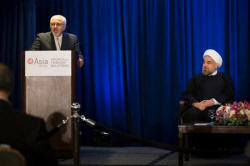|
 A
look at Iran nuclear sites from mine to reactor A
look at Iran nuclear sites from mine to reactor
 Send a link to a friend
Send a link to a friend
[November 20, 2013]
(AP) — Nuclear talks resume Wednesday between
Iran and world powers after the last round stalled over issues that
include Iran's planned heavy water reactor and the levels of uranium
enrichment. Iran later agreed to provide U.N. nuclear inspectors with
greater information and access, but it's uncertain whether the
concessions will be enough to push envoys in Geneva closer to a deal.
Iran seeks a rollback in U.S.-led economic sanctions, while the West is
pressing it to curb its uranium enrichment — the process to make nuclear
fuel. In the past decade, Iran's nuclear program has advanced on many
fronts and more facilities are planned.
|
|
 RAISED AT TALKS: RAISED AT TALKS:
ARAK HEAVY WATER REACTOR: Such reactors can run on
non-enriched uranium as fuel and uses a molecular variant of
water as a coolant. Heavy water reactors also produce more
plutonium byproducts than conventional reactors. Plutonium can
be used in nuclear weapons. Iran began work on its facility in
2004 in Arak, about 250 kilometers (150 miles) southwest of
Tehran. U.N. nuclear inspectors have visited the site, but have
been promised wider access under the latest accord between Iran
and the U.N's International Atomic Energy Agency, or IAEA. The
reactor is nearing completion, but no specific date has been
announced to begin operations. Iran says the reactor will be
used to produce isotopes for medical and industrial uses. The
country also does not possess the technology needed to reprocess
the plutonium byproducts for possible use in nuclear arms.
ENRICHMENT SITES: Iran has two main uranium enrichment
facilities. The oldest and largest — in Natanz, about 260
kilometers (160 miles) southeast of Tehran — is largely built
underground and is surrounded by anti-aircraft batteries.
Uranium enrichment began in 2006. Another site is known as
Fordo, which is built into a mountainside south of Tehran. Its
construction was kept secret by Iran until it was disclosed in
September 2009 in a pre-emptive move before its existence was
revealed by Western intelligence agencies. The area is heavily
protected by the Revolutionary Guard. U.N. nuclear inspectors
have visited both sides and have installed round-the-clock
monitoring systems.

___
OTHER REACTORS:
BUSHEHR: Iran's first energy-producing nuclear reactor,
which began full operations in early 2013. U.N. inspectors
frequently visit the site.
TEHRAN: The main research reactor is in Iran's capital,
mainly involved in producing isotopes for cancer treatment. U.N.
inspectors have access to the site.
PLANNED: Iranian officials have noted various plans for
more reactors over the next 20 years, but no firm details have
been released and progress is unclear. The most discussed
proposal is an energy-producing reactor in Darkhovin, in the
southwestern Khuzestan province, built entirely with domestic
technology. Iran has pledged to give the IAEA a full accounting
of its proposals.
___
[to top of second column] |

URANIUM MINES AND PROCESSING:
SAGHAND: Iran's main uranium mine, in the central province of
Yazd. It is the country's principal source of uranium ore. Iran has
granted U.N. inspectors access.
GACHIN: A smaller uranium mining site and processing facility
near Bandar Abbas on the Persian Gulf. U.N. inspectors were promised
access in the recent deal with the IAEA.
ARDAKAN: A planned plant for processing uranium ore into
yellowcake, a uranium concentrate that is the basic feedstock in the
steps to make nuclear fuel. The plant, about 500 kilometers (300
miles) southeast of Tehran, is not yet in operation. The other site,
Gachin, has produced small amounts of yellowcake since 2006.
ISFAHAN URANIUM CONVERSION FACILITY: A plant that reprocesses
yellowcake into a gas, which is then fed into centrifuges for
enrichment. A separate facility in Isfahan, about 250 kilometers
(150 miles) south of Tehran, produces non-enriched fuel for the
planned Arak reactor.
PLANNED: Iran claims it seeks to build 10 new uranium
enrichment sites, but details and timetables have not been made
clear.
____
DISPUTED SITE:
PARCHIN MILITARY BASE: The base, southeast of Tehran, is a hub
for Iran's conventional munitions industry. The site has also been
suspected of housing a secret underground facility used for blast
tests related to potential nuclear triggers. Iran denies the claim.
IAEA inspectors visited the site twice in 2005, but only examined
one of four areas of potential interest. The U.N. nuclear chief,
Yukiya Amano, said he hopes to raise the issue of a repeat
inspection in future talks with Iranian officials.
[Associated
Press]
Copyright 2013 The Associated
Press. All rights reserved. This material may not be published,
broadcast, rewritten or redistributed.
 |